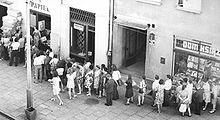Shortage economy
Shortage economy is a term going back to the Hungarian economist János Kornai , which is used to describe the central administration economy (planned economy) of the real socialist states.
General
In a scarcity economy, there is a shortage of goods or services while there is enough money to buy those goods. In his book Economics of Shortage in 1980, János Kornai stated that the chronic shortage of goods in the countries of the Eastern Bloc in the late 1970s (which continued into the 1980s) was not a planning error or a price error , but a fundamental feature of the communist system. A shortage economy does not necessarily mean that there is "nothing", but rather describes a form of goods distribution in which money does not play the decisive role and demand exceeds the available supply of goods. At the same time as the shortage, there can also be an excess of certain products. When purchasing scarce products, factors such as queuing, searching, waiting lists, social status or alternative currencies ( foreign exchange, etc.) often play a role. One of the main causes of the constant shortage is the inadequate production due to the lack of incentives for the producers, which turns the planned economy into a seller's market, whereas in most functioning market economies a constant excess is produced, which leads to a market supply oriented towards the consumer.
GDR
In the economy of the GDR there were bottlenecks, especially for high-demand goods . Families had to wait around five years for an apartment, ten years for a telephone and 15 years for a Wartburg car . There was also a shortage of high-quality clothing, attractive furniture and bed linen, special types of meat and sausage, a wide selection of fruit and vegetables, but also elementary services such as workshops, driving schools and craftsmen. In order to alleviate the shortage of high-demand goods, exquisite and delicatessen shops were set up, in which special clothing and special food were sold at high prices. High-quality electrical devices such as color TVs or stereo systems were also sold at very high prices or were available in so-called Intershops for freely convertible currencies .
Although the supply situation improved steadily in absolute terms, a massive excess purchasing power could not be prevented: Private savings balances rose continuously as a result of rising wages and good interest rates on savings deposits, while dissatisfaction with the range of goods remained. For example, it was hardly possible to buy building material or sanitary fixtures privately in a simple way. The waiting time for cars had increased to more than 10 years in the 1980s. In the service sector, too, the constant shortage has not changed. Accordingly, the existing needs were often met not with money, but only with long queues or lists, personal contacts or political privileges, but also with payment in freely convertible currencies.
This led to an enormous lack of transparency, planning uncertainty, injustice and thus to dissatisfaction among the population. But the economy was also adversely affected: the constant lack of clarity as to whether and when the required goods were actually available in the desired quantity resulted in enormous planning uncertainty. New projects in particular were often nipped in the bud and investments, once approved, were highly ineffective. This was one of the reasons why it was not possible to keep up with the economic development in West Germany.
Western packages from families and friends from the Federal Republic of Germany helped many East Germans to close supply gaps. 28 million Western parcels were sent to the GDR in 1988. Facilities such as Genex and Intershop were designed to improve the supply situation and foreign exchange income through gifts or investments by West Germans.
After the end of the Eastern Bloc
The term scarcity economy is also used to describe the economy in Cuba and North Korea or in Venezuela (since 2015).
literature
- János Kornai: Economics of Shortage . 2 volumes, North-Holland, Amsterdam 1980, ISBN 0-444-86059-2 , ISBN 0-444-85426-6 (volume 1), ISBN 0-444-86058-4 (volume 2).
See also
- Coffee crisis in the GDR (1977)
Web links
- We adapt to the situation. on the economy of scarcity in Cuba, daily newspaper, August 1, 2003
- "From Konsummm to Konsuuum": Exhibition on the subject of shopping , Berliner Zeitung, December 4, 1997
- The subject of shortage economy in the House of History
- Deficiency diary
Individual evidence
- ↑ János Kornai, Economics of Shortage , 1980, pp. 547 ff.
- ↑ https://www.kas.de/web/ddr-mythos-und-reallichkeit/lebensstandard
- ^ Shortage economy on the website of the House of History
- ↑ We adapt to the situation. on the shortage economy in Cuba, daily newspaper, August 1, 2003
- ↑ https://www.zdf.de/dokumentation/zdfinfo-doku/gold-fuer-kim-ein-leben-fuer-nordkoreas-fuehrer-102.html
- ↑ https://www.welt.de/wirtschaft/gallery133696561/Schlange-haben-fuer-Lebensmittel-in-Venezuela.html

